2011 Peugeot 3008 Hybrid 4 ECU
[x] Cancel search: ECUPage 124 of 280
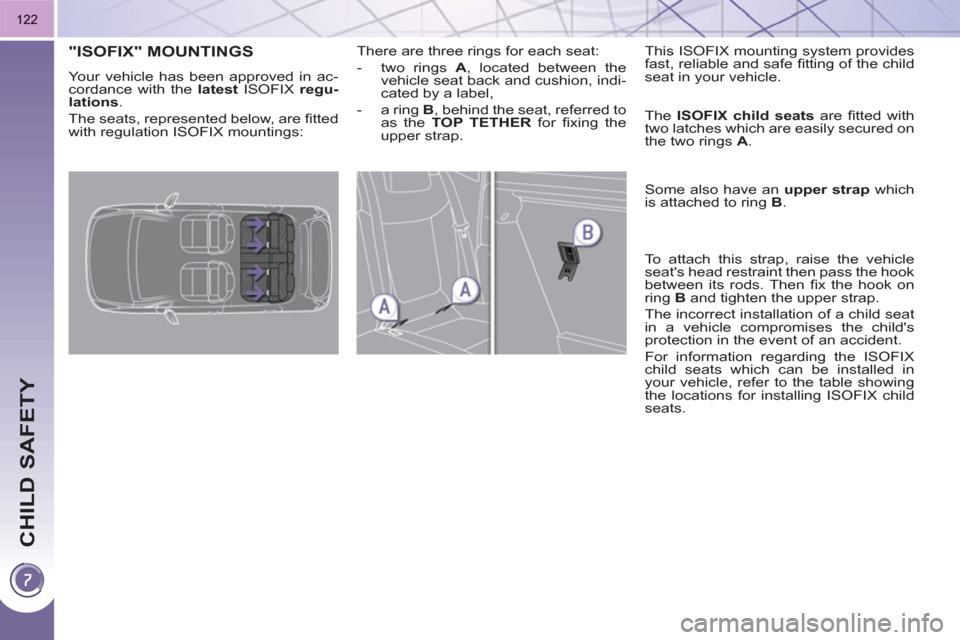
CHILD SAFETY
122
"ISOFIX" MOUNTINGS
Your vehicle has been approved in ac-
cordance with the latest
ISOFIX regu-
lation
s
.
The seats, represented below, are fi tted
with regulation ISOFIX mountings: There are three rings for each seat:
- two rings A
, located between the
vehicle seat back and cushion, indi-
cated by a label,
- a ring B
, behind the seat, referred to
as the TOP TETHER
for fi xing the
upper strap. This ISOFIX mounting system provides
fast, reliable and safe fi tting of the child
seat in your vehicle.
The ISOFIX child seats
are fi tted with
two latches which are easily secured on
the two rings A
.
Some also have an upper strap
which
is attached to ring B
.
To attach this strap, raise the vehicle
seat's head restraint then pass the hook
between its rods. Then fi x the hook on
ring B
and tighten the upper strap.
The incorrect installation of a child seat
in a vehicle compromises the child's
protection in the event of an accident.
For information regarding the ISOFIX
child seats which can be installed in
your vehicle, refer to the table showing
the locations for installing ISOFIX child
seats.
Page 125 of 280
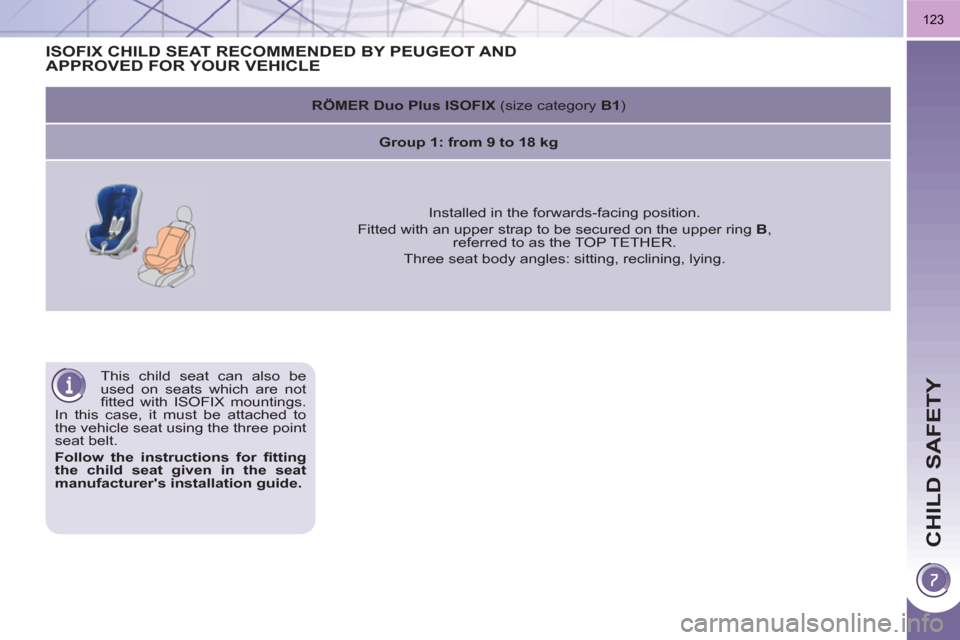
CHILD SAFETY
123
This child seat can also be
used on seats which are not
fi tted with ISOFIX mountings.
In this case, it must be attached to
the vehicle seat using the three point
seat belt.
Follow the instructions for fi tting
the child seat given in the seat
manufacturer's installation guide.
ISOFIX CHILD SEAT RECOMMENDED BY PEUGEOT ANDAPPROVED FOR YOUR VEHICLE
RÖMER Duo Plus ISOFIX
(size category B1
)
Group 1: from 9 to 18 kg
Installed in the forwards-facing position.
Fitted with an upper strap to be secured on the upper ring B
,
referred to as the TOP TETHER.
Three seat body angles: sitting, reclining, lying.
Page 126 of 280
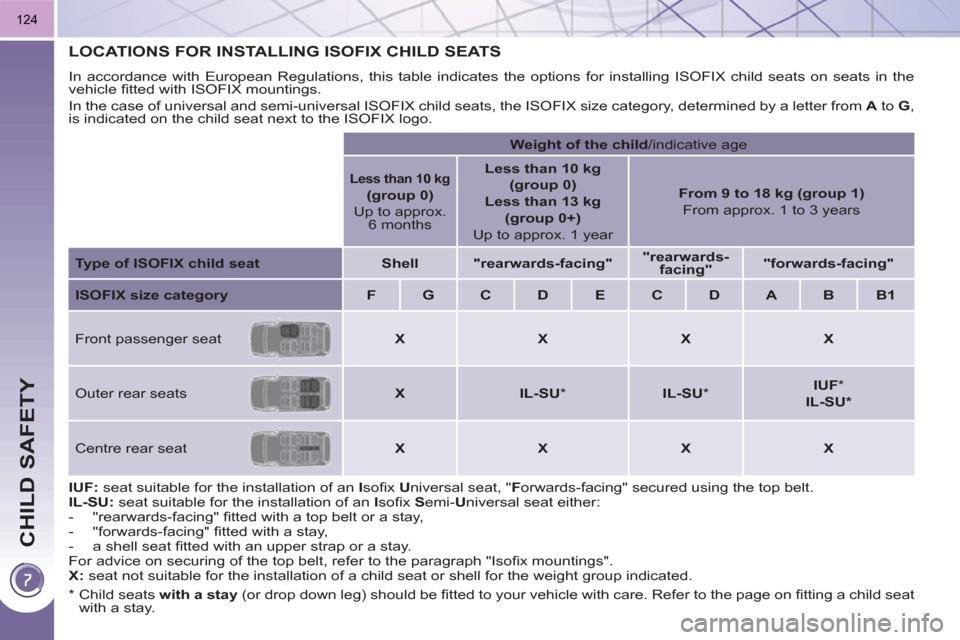
CHILD SAFETY
124
LOCATIONS FOR INSTALLING ISOFIX CHILD SEATS
In accordance with European Regulations, this table indicates the options for installing ISOFIX child seats on seats in the
vehicle fi tted with ISOFIX mountings.
In the case of universal and semi-universal ISOFIX child seats, the ISOFIX size category, determined by a letter from A
to G
,
is indicated on the child seat next to the ISOFIX logo.
IUF:
seat suitable for the installation of an I
sofi x U
niversal seat, " F
orwards-facing" secured using the top belt.
IL-SU:
seat suitable for the installation of an I
sofi x S
emi- U
niversal seat either:
- "rearwards-facing" fi tted with a top belt or a stay,
- "forwards-facing" fi tted with a stay,
- a shell seat fi tted with an upper strap or a stay.
For advice on securing of the top belt, refer to the paragraph "Isofi x mountings".
X:
seat not suitable for the installation of a child seat or shell for the weight group indicated.
Weight of the child
/indicative age
Less than 10 kg
(group 0)
Up to approx.
6 months
Less than 10 kg
(group 0)
Less than 13 kg
(group 0+)
Up to approx. 1 year
From 9 to 18 kg (group 1)
From approx. 1 to 3 years
Type of ISOFIX child seat
Shell
"rearwards-facing"
"rearwards-
facing"
"forwards-facing"
ISOFIX size category
F
G
C
D
E
C
D
A
B
B1
Front passenger seat
X
X
X
X
Outer rear seats
X
IL-SU
*
IL-SU
*
IUF
*
IL-SU *
Centre rear seat
X
X
X
X
*
Child seats with a
stay
(or drop down leg) should be fi tted to your vehicle with care. Refer to the page on fi tting a child seat
with a stay.
Page 133 of 280
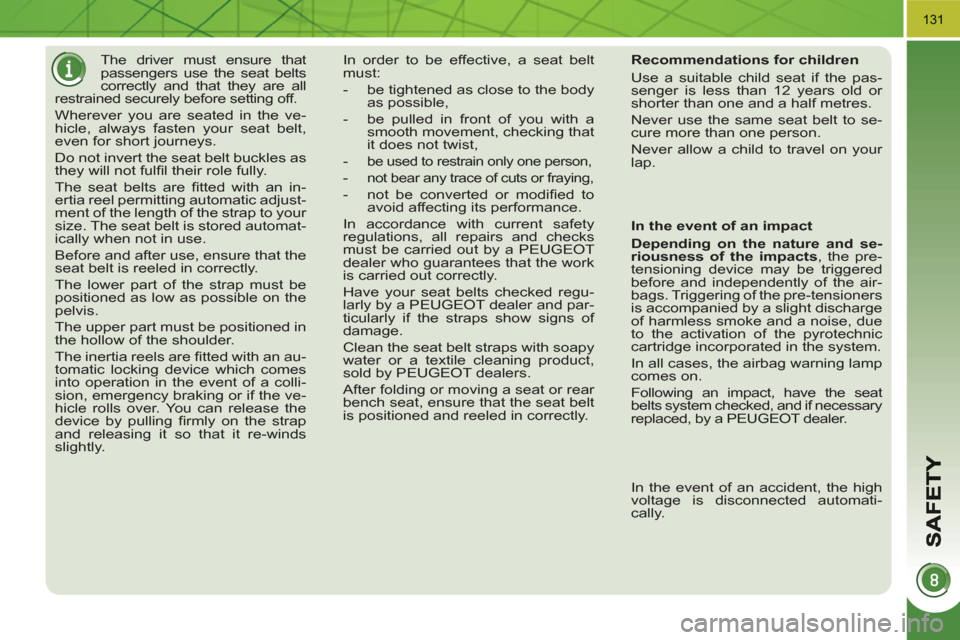
131
The driver must ensure that
passengers use the seat belts
correctly and that they are all
restrained securely before setting off.
Wherever you are seated in the ve-
hicle, always fasten your seat belt,
even for short journeys.
Do not invert the seat belt buckles as
they will not fulfi l their role fully.
The seat belts are fi tted with an in-
ertia reel permitting automatic adjust-
ment of the length of the strap to your
size. The seat belt is stored automat-
ically when not in use.
Before and after use, ensure that the
seat belt is reeled in correctly.
The lower part of the strap must be
positioned as low as possible on the
pelvis.
The upper part must be positioned in
the hollow of the shoulder.
The inertia reels are fi tted with an au-
tomatic locking device which comes
into operation in the event of a colli-
sion, emergency braking or if the ve-
hicle rolls over. You can release the
device by pulling fi rmly on the strap
and releasing it so that it re-winds
slightly. In order to be effective, a seat belt
must:
- be tightened as close to the body
as possible,
- be pulled in front of you with a
smooth movement, checking that
it does not twist,
-
be used to restrain only one person,
- not bear any trace of cuts or fraying,
- not be converted or modifi ed to
avoid affecting its performance.
In accordance with current safety
regulations, all repairs and checks
must be carried out by a PEUGEOT
dealer who guarantees that the work
is carried out correctly.
Have your seat belts checked regu-
larly by a PEUGEOT dealer and par-
ticularly if the straps show signs of
damage.
Clean the seat belt straps with soapy
water or a textile cleaning product,
sold by PEUGEOT dealers.
After folding or moving a seat or rear
bench seat, ensure that the seat belt
is positioned and reeled in correctly.
Recommendations for children
Use a suitable child seat if the pas-
senger is less than 12 years old or
shorter than one and a half metres.
Never use the same seat belt to se-
cure more than one person.
Never allow a child to travel on your
lap.
In the event of an impact
Depending on the nature and se-
riousness of the impacts
, the pre-
tensioning device may be triggered
before and independently of the air-
bags. Triggering of the pre-tensioners
is accompanied by a slight discharge
of harmless smoke and a noise, due
to the activation of the pyrotechnic
cartridge incorporated in the system.
In all cases, the airbag warning lamp
comes on.
Following an impact, have the seat
belts system checked, and if necessary
replaced, by a PEUGEOT dealer.
In the event of an accident, the high
voltage is disconnected automati-
cally.
Page 137 of 280
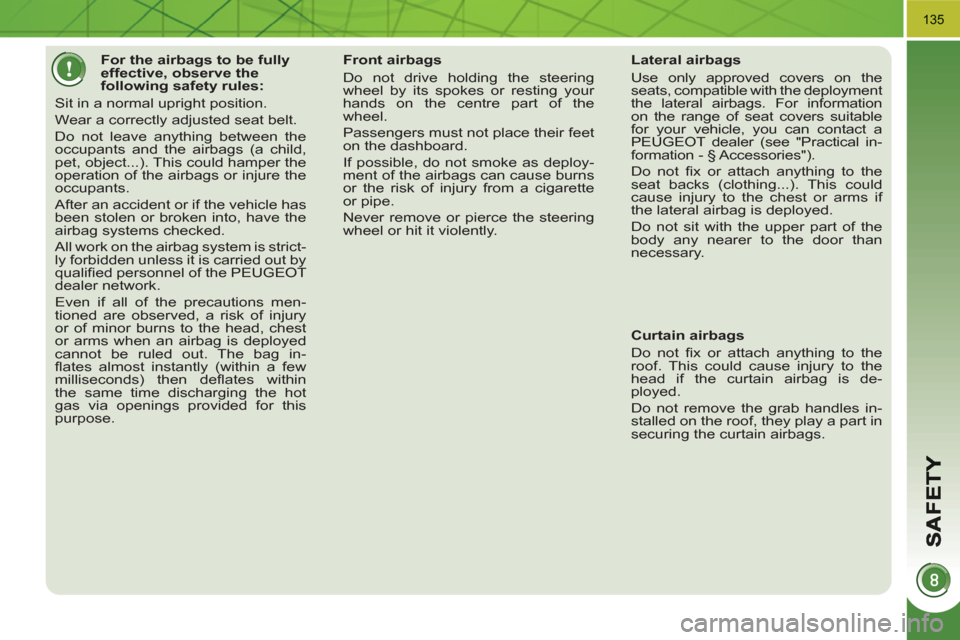
135
For the airbags to be fully
effective, observe the
following safety rules:
Sit in a normal upright position.
Wear a correctly adjusted seat belt.
Do not leave anything between the
occupants and the airbags (a child,
pet, object...). This could hamper the
operation of the airbags or injure the
occupants.
After an accident or if the vehicle has
been stolen or broken into, have the
airbag systems checked.
All work on the airbag system is strict-
ly forbidden unless it is carried out by
qualifi ed personnel of the PEUGEOT
dealer network.
Even if all of the precautions men-
tioned are observed, a risk of injury
or of minor burns to the head, chest
or arms when an airbag is deployed
cannot be ruled out. The bag in-
fl ates almost instantly (within a few
milliseconds) then defl ates within
the same time discharging the hot
gas via openings provided for this
purpose.
Front airbags
Do not drive holding the steering
wheel by its spokes or resting your
hands on the centre part of the
wheel.
Passengers must not place their feet
on the dashboard.
If possible, do not smoke as deploy-
ment of the airbags can cause burns
or the risk of injury from a cigarette
or pipe.
Never remove or pierce the steering
wheel or hit it violently.
Lateral airbags
Use only approved covers on the
seats, compatible with the deployment
the lateral airbags. For information
on the range of seat covers suitable
for your vehicle, you can contact a
PEUGEOT dealer (see "Practical in-
formation - § Accessories").
Do not fi x or attach anything to the
seat backs (clothing...). This could
cause injury to the chest or arms if
the lateral airbag is deployed.
Do not sit with the upper part of the
body any nearer to the door than
necessary.
Curtain airbags
Do not fi x or attach anything to the
roof. This could cause injury to the
head if the curtain airbag is de-
ployed.
Do not remove the grab handles in-
stalled on the roof, they play a part in
securing the curtain airbags.
Page 159 of 280
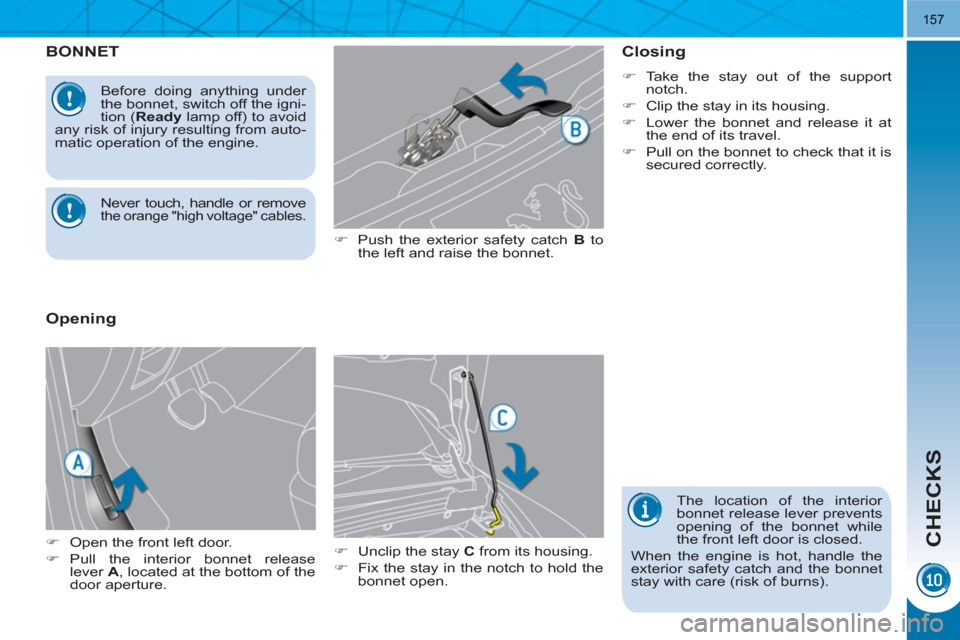
CHECKS
157
BONNET
�)
Push the exterior safety catch B
to
the left and raise the bonnet.
�)
Unclip the stay C
from its housing.
�)
Fix the stay in the notch to hold the
bonnet open.
Closing
�)
Take the stay out of the support
notch.
�)
Clip the stay in its housing.
�)
Lower the bonnet and release it at
the end of its travel.
�)
Pull on the bonnet to check that it is
secured correctly.
Opening
The location of the interior
bonnet release lever prevents
opening of the bonnet while
the front left door is closed.
When the engine is hot, handle the
exterior safety catch and the bonnet
stay with care (risk of burns).
Before doing anything under
the bonnet, switch off the igni-
tion ( Ready
lamp off) to avoid
any risk of injury resulting from auto-
matic operation of the engine.
�)
Open the front left door.
�)
Pull the interior bonnet release
lever A
, located at the bottom of the
door aperture.
Never touch, handle or remove
the orange "high voltage" cables.
Page 165 of 280
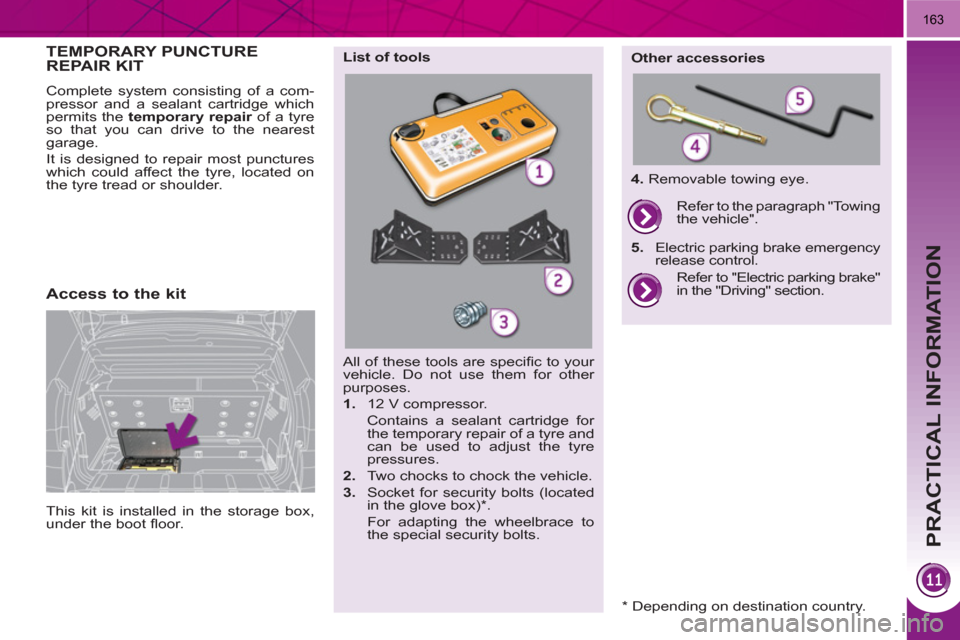
PRACTICAL INFORMATION
163
All of these tools are specifi c to your
vehicle. Do not use them for other
purposes.
1.
12 V compressor.
Contains a sealant cartridge for
the temporary repair of a tyre and
can be used to adjust the tyre
pressures.
2.
Two chocks to chock the vehicle.
3.
Socket for security bolts (located
in the glove box) * .
For adapting the wheelbrace to
the special security bolts.
List of tools
Other accessories
4.
Removable towing eye.
Refer to "Electric parking brake"
in the "Driving" section.
Refer to the paragraph "Towing
the vehicle".
5.
Electric parking brake emergency
release control.
TEMPORARY PUNCTUREREPAIR KIT
Complete system consisting of a com-
pressor and a sealant cartridge which
permits the temporary repair
of a tyre
so that you can drive to the nearest
garage.
It is designed to repair most punctures
which could affect the tyre, located on
the tyre tread or shoulder.
Access to the kit
This kit is installed in the storage box,
under the boot fl oor.
*
Depending on destination country.
Page 171 of 280

PRACTICAL INFORMATION
169
CHANGING A WHEEL
The tools are stowed in the boot.
Access to the tools
Procedure for changing a faulty wheel
for the spare wheel using the tools pro-
vided with the vehicle.
All of these tools are specifi c to your
vehicle. Do not use them for other
purposes.
1.
Wheelbrace *
.
For removing the wheel trim and
removing the wheel fi xing bolts.
2.
Jack with integral handle *
.
For raising the vehicle.
3.
"Bolt cover" tool (according to
equipment) *
.
For removing the bolt protectors
(covers) on alloy wheels.
4.
Centring guide *
.
For refi tting an alloy wheel to the
hub.
List of tools
Other accessories
5.
Socket for the security bolts
(located in the glove box) *
.
For adapting the wheelbrace to
the special "security" bolts.
6.
Two chocks to immobilise the
vehicle.
7.
Removable towing eye.
Refer to "Electric parking brake"
in the "Driving" section.
Refer to the paragraph "Towing
the vehicle".
8.
Electric parking brake emergency
release control.
Before doing any work on your
vehicle, switch off the ignition
( Ready
lamp off) to avoid any
risk of injury resulting from automatic
operation of the engine.
*
According to country.
Take care to use the jacking
points provided for the jack to
avoid damaging the cables.